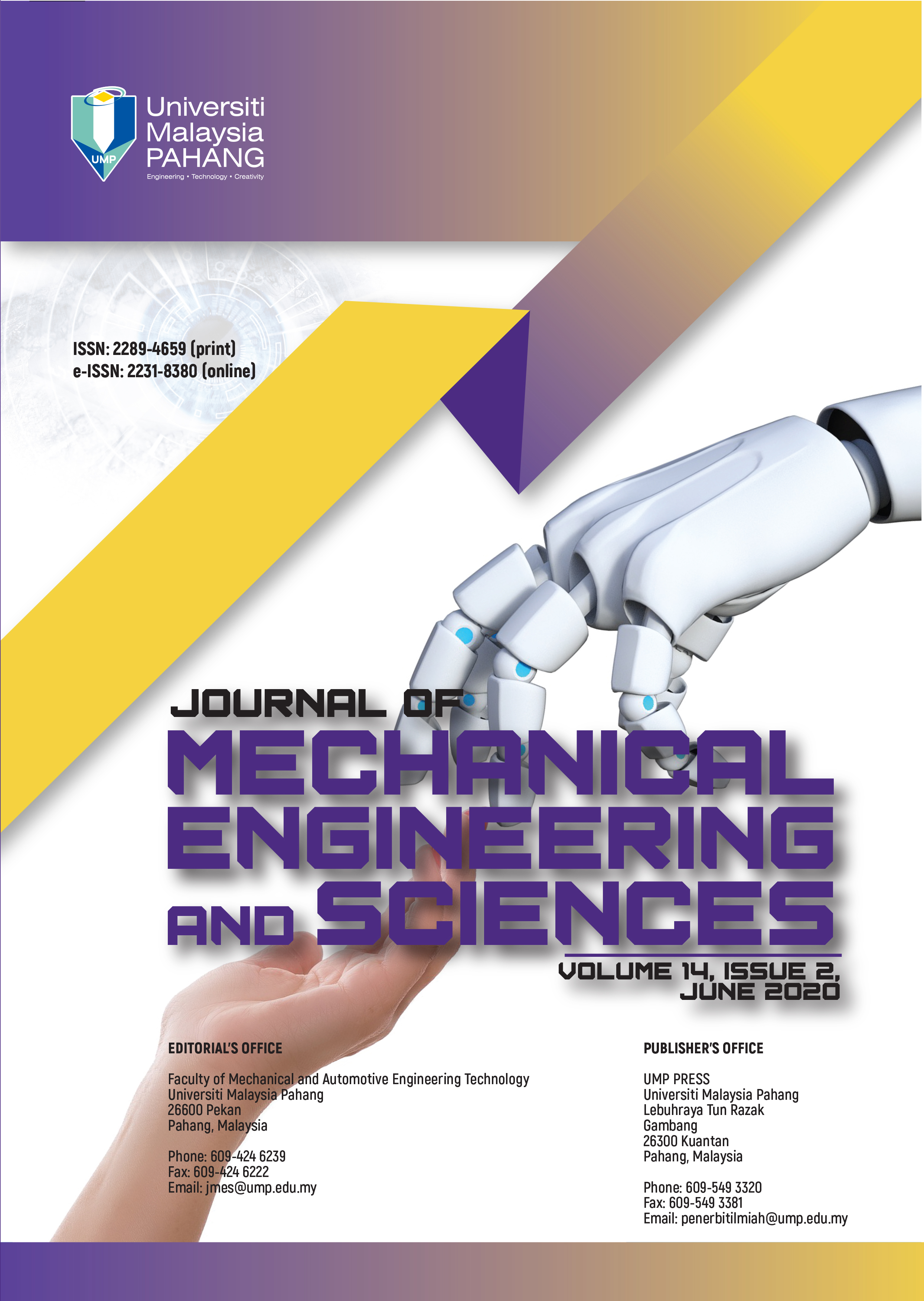RANS study of very high Reynolds-number plane turbulent Couette flow
DOI:
https://doi.org/10.15282/jmes.14.2.2020.10.0522Keywords:
Turbulent flows, Couette Flow, RANS, turbulence models, high Reynolds number, k-omega, k-epsilonAbstract
The objective of this study is to expound on the deliverables of a steady-state RANS (Reynolds Averaged Navier Stokes) simulation in one of the simplest flows, Couette flow, at a very high Reynolds number. To that end, a process to perform better grid sensitivity testing is introduced. Three two-equation turbulence models ( , , and ) are compared against each other as well as pitted against formal literature on the subject and core flow velocities, slopes, wall-bounded velocities, shear stresses and kinetic energies are analyzed. applied with enhanced wall functions is consistently found to be in better agreement with previous studies. Finally, plane turbulent Couette flow at 51,099, the range at which it has not been studied experimentally, numerically or analytically in former studies, is simulated. The results are found to be consistent with the trends asserted by literature and preliminary computations of this study.
References
J. M. Robertson, “On Turbulent Plane-Couette Flow,” in Proceedings of the sixth Midwestern Conference on Fluid Mechanics, 1959, pp. 169–182.
H. Reichardt, “Über die Geschwindigkeitsverteilung in einer geradlinigen turbulenten Couetteströmung,” Zeitschrift für Angew. Math. und Mech., vol. 36, pp. 26–29, 1956.
H. J. Leutheusser and V. H. Chu, “Experiments on Plane Couette Flow,” J. Hydraul. Div., vol. 97, no. 9, pp. 1269–1284, 1971.
M. Aydin and H. J. Leutheusser, “Novel experimental facility for the study of plane Couette flow,” Rev. Sci. Instrum., vol. 50, no. 11, pp. 1362–1366, 1979, doi: 10.1063/1.1135726.
M. M. M. El Telbany and A. J. Reynolds, “The Structure of Turbulent Plane Couette Flow,” J. Fluids Eng., vol. 104, no. 3, p. 367, 2009, doi: 10.1115/1.3241853.
N. Tillmark and P. H. Alfredsson, “Experiments on transition in plane Couette flow,” J. Fluid Mech., vol. 235, no. HY9, pp. 89–102, 1992.
F. S. Henry and A. J. Reynolds, “Analytical Solution of Two Gradient-Diffusion Models Applied to Turbulent Couette Flow,” J. Fluids Eng., vol. 106, no. 2, p. 211, 2009, doi: 10.1115/1.3243104.
H. I. Andersson and B. A. Pettersson, “Modeling plane turbulent Couette flow,” Int. J. Heat Fluid Flow, vol. 15, no. 6, pp. 447–455, 1994, doi: 10.1016/0142-727X(94)90003-5.
S. Nisizima and A. Yoshizawa, “Turbulent channel and Couette flows using an anisotropic k-epsilon model,” Am. Inst. Aeronaut. Astronaut. J., vol. 25, no. 3, pp. 414–420, 2008, doi: 10.2514/3.9639.
J. C. Monnier and M. Stanislas, “Critical examination of various turbulence models applied to different one-dimensional internal flows,” in Proceedings of the Sixth International Conference on Numerical Methods in Laminar and Turbulent Flow, 1989, pp. 297–306.
H. S. Zhang, R. M. C. So, and M. L. Zhu, “A near-wall second-order turbulence model for wall-bounded flows,” in Ninth Symposium of Turbulent Shear Flows, 1993, pp. 8.2.1-8.2.6.
H. Sund, “Validation of a second-moment closure to low Reynolds number plane Couette flow,” in Proceedings of the Eighth International Conference on Numerical Methods in Laminar and Turbulent Flow, 1993, pp. 241–248.
L. S. Tuckerman, M. Chantry, and D. Barkley, “Patterns in Wall-Bounded Shear Flows,” Annu. Rev. Fluid Mech., vol. 52, no. 1, pp. 343–367, Jan. 2020, doi: 10.1146/annurev-fluid-010719-060221.
M. J. Lee and J. Kim, “The structure of turbulence in a simulated plane Couette flow,” in 8th Symposium on Turbulent Shear Flows; Sept. 9-11, 1991, pp. 5.3.1-5.3.5.
A. Pershin, C. Beaume, and S. M. Tobias, “Dynamics of spatially localized states in transitional plane Couette flow,” J. Fluid Mech., 2019, doi: 10.1017/jfm.2019.154.
B. Eckhardt and S. Zammert, “Small scale exact coherent structures at large Reynolds numbers in plane Couette flow,” Nonlinearity, Oct. 2017, doi: 10.1088/1361-6544/aa9462.
D. Olvera and R. R. Kerswell, “Exact coherent structures in stably stratified plane Couette flow,” J. Fluid Mech., 2017, doi: 10.1017/jfm.2017.447.
T. Kawata and T. Tsukahara, “Numerical investigation on scale-by-scale Reynolds stress transport in plane Couette turbulence,” in 11th International Symposium on Turbulence and Shear Flow Phenomena, TSFP 2019, 2019.
T. Kawata and P. H. Alfredsson, “Inverse Interscale Transport of the Reynolds Shear Stress in Plane Couette Turbulence,” Phys. Rev. Lett., 2018, doi: 10.1103/PhysRevLett.120.244501.
P. R. Spalart, A. Garbaruk, and M. Strelets, “RANS Solutions in Couette flow with streamwise vortices,” Int. J. Heat Fluid Flow, 2014, doi: 10.1016/j.ijheatfluidflow.2014.04.010.
J. Guo, “General Mean Velocity Distribution Law for Smooth-Wall Plane Couette Flow,” J. Eng. Mech., vol. 144, no. 1, p. 04017146, Jan. 2018, doi: 10.1061/(ASCE)EM.1943-7889.0001370.
K. Duraisamy, G. Iaccarino, and H. Xiao, “Turbulence Modeling in the Age of Data,” Annu. Rev. Fluid Mech., Mar. 2018, doi: 10.1146/annurev-fluid-010518-040547.
M. Kaandorp, “Machine Learning for Data-Driven RANS Turbulence Modelling,” Delft Univ. Technol., 2018.
S. Hoyas and J. Jiménez, “Scaling of the velocity fluctuations in turbulent channels up to Reτ=2003,” Phys. Fluids, 2006, doi: 10.1063/1.2162185.
E. V Mortikov, A. V Glazunov, and V. N. Lykosov, “Numerical study of plane Couette flow: turbulence statistics and the structure of pressure–strain correlations,” Russ. J. Numer. Anal. Math. Model., vol. 34, no. 2, pp. 119–132, Apr. 2019, doi: 10.1515/rnam-2019-0010.
S. Pirozzoli, M. Bernardini, and P. Orlandi, “Turbulence statistics in Couette flow at high Reynolds number,” J. Fluid Mech., vol. 758, pp. 327–343, 2014, doi: 10.1017/jfm.2014.529.
S. A. Orszag, “Analytical theories of turbulence,” J. Fluid Mech., vol. 41, no. 2, pp. 363–386, 1970, doi: 10.1017/S0022112070000642.
I. B. (Wester. V. U. Celik, “Introductory turbulence modeling,” 1999.
F. R. Menter, “Two-equation eddy-viscosity turbulence models for engineering applications,” Am. Inst. Aeronaut. Astronaut. J., vol. 32, no. 8, pp. 1598–1605, 1994, doi: 10.2514/3.12149.
S. B. Pope, Turbulent Flows. New York: Cambridge University Press, 2000.
“Near-Wall Treatments for Wall Bounded Turbulent Flows,” 2009. .
G. Biswas and V. Eswaran, Turbulent Flows: Fundamentals, Experiments and Modeling, 1st ed. Narosa, 2002.
F. H. Busse, “Bounds for turbulent shear flow,” J. Fluid Mech., vol. 41, no. 1, pp. 219–240, 1970, doi: 10.1017/S0022112070000599.
A. A. Townsend, The Structure of Turbulent Shear Flow, 2nd ed. Cambridge University Press, 1976.
O. Kitoh, K. Nakabayashi, and F. Nishimura, “Experimental study on mean velocity and turbulence characteristics on plane Couette flow: low-Reynolds-number effects and large longitudinal vortical structures,” J. Fluid Mech., pp. 199–227, 2005.
J. Komminaho, A. Lundbladh, and A. V Johansson, “Very large structures in plane turbulent Couette flow,” J. Fluid Mech., vol. 320, pp. 259–258, 1996.
T. Tsukahara, H. Kawamura, and K. Shingai, “DNS of turbulent Couette flow with emphasis on the large-scale structure in the core region,” J. Turbul., vol. 7, pp. 1–16, 2006.
B. E. Launder and N. Shima, “Second-moment closure for the near-wall sublayer: development and application,” Am. Inst. Aeronaut. Astronaut. J., vol. 27, pp. 1319–1325, 1989.
K. H. Bech, N. Tillmark, P. H. Alfredsson, and H. I. Andersson, “An investigation of turbulent plane Couette flow at low Reynolds numbers,” J. Fluid Mech., vol. 286, pp. 291–325, 1995.
H. Schlichting and K. Gersten, Boundary Layer Theory, 8th ed. Springer, 2000.
Downloads
Published
Issue
Section
License
Copyright (c) 2020 The Author(s)

This work is licensed under a Creative Commons Attribution-NonCommercial 4.0 International License.






